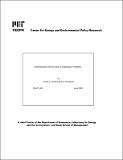| dc.contributor.author | Smith, James L. | en_US |
| dc.contributor.author | Thompson, Rex W. | en_US |
| dc.contributor.other | Massachusetts Institute of Technology. Center for Energy and Environmental Policy Research. | en_US |
| dc.date.accessioned | 2009-04-03T17:06:44Z | |
| dc.date.available | 2009-04-03T17:06:44Z | |
| dc.date.issued | 2005 | en_US |
| dc.identifier | 2005-007 | en_US |
| dc.identifier.uri | http://hdl.handle.net/1721.1/45037 | |
| dc.description.abstract | Conventional wisdom holds that dependence among geological prospects increases exploration risk. However, dependence also creates the option to truncate exploration if early results are discouraging. We show that the value of this option creates incentives for explorationists to plunge into dependence; i.e., to assemble portfolios of highly correlated exploration prospects. Risk-neutral and risk-averse investors are distinguished not by the plunging phenomenon, but by the threshold level of dependence that triggers such behavior. Aversion to risk does not imply aversion to dependence. Indeed the potential to plunge may be larger for risk-averse investors than for risk-neutral investors. | en_US |
| dc.format.extent | 33 p | en_US |
| dc.publisher | MIT Center for Energy and Environmental Policy Research | en_US |
| dc.relation.ispartofseries | MIT-CEEPR (Series) ; 05-007WP. | en_US |
| dc.title | Diversification and the value of exploration portfolios | en_US |
| dc.type | Working Paper | en_US |
| dc.identifier.oclc | 61198975 | en_US |
